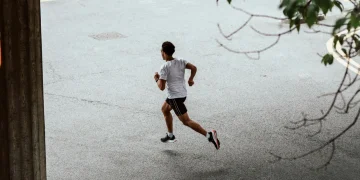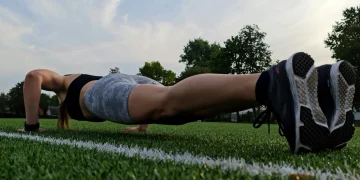Lower back pain after running is quite common because the spine experiences enormous stress due to the axial nature of the loads. The load can increase exponentially with the wrong running technique and incorrect shoes. Muscles, ligaments, and intervertebral discs simply can not endure it. Areas experience trauma, which in turn leads to an inflammatory process.
The Causes of Lower Back Pain While Running
Lower back pain from running is often the result of long workouts without rest. Pain can also be associated with poor posture, a difference in leg length (artificial or natural), or weakness in the back muscles.
Pain can occur in the sacroiliac joints, the lumps of the lower back above the buttocks. If you land harder on one leg than the other during a run, excessive pressure can build up through one of the sacroiliac joints or, less commonly, through both joints at the same time, causing joint irritation, inflammation, and pain.
Weak muscles in the lower back and lower abs lead to loss of movement control while running. When we get tired, the muscles cannot control the running step, which leads to a load on the spine and, as a result, lower back pain from running occurs.
The causes of lower back pain while running and subsequent injuries may be an imbalance in the development of muscles on different sides of the back and the development of leg strength. The result is pain and inflammation.
“Inflammation, or local swelling, is part of the body’s natural response to injury, in which blood is rushed to injured tissue in order to restore it. Inflamed muscles may spasm, feel tender to the touch, or cramp, and contract tightly, causing intense pain”, says Kojo Hamilton, MD
- If the pain is aching, not constant, try stretching the muscles of the lower back. For this, exercises from yoga and Pilates are suitable – read about them below.
- If the pain is acute, constant, and radiates or is accompanied by numbness or weakness of the limb, it may indicate a more serious problem—for example, a prolapsed intervertebral disc.
Acute pain with numbness can be a harbinger of a herniated disc – this is a common problem among runners, associated with the peculiarities of the load that falls on the spine during running.
How to Prevent Lower Back Pain When Running
If you feel lower back tightness while running, you’ll need to stretch. For this, exercises from yoga and pilates are well suited:
- plow – in the prone position, lift your legs (straight or slightly bent) behind the head;
- child’s pose – from a sitting position on your knees, lie with your stomach on your hips, try to put your head on the floor, and achieve maximum relaxation;
- scorpio – lying on your stomach, spread your arms to the sides and alternately try to reach the palm of the foot of the opposite leg.
You can increase the mobility of the lumbar area with the following exercise:
- Stand on a yoga block (or any small elevation), one foot on the block, the other without support; lower your free leg to the floor while both legs remain straight – there should be no bending at the knee! Try to move your pelvis.
You can strengthen your back muscles with the help of these exercises from the International Spine Institute:
- deadlift;
- planks;
- mountain climbers: in the plank position, take one knee to your chest and back again, then change and do the same with the other knee.
It is also worth reconsidering your running shoes: Keep track of the mileage you’ve run in each pair of shoes – if you’ve run more than 600 miles in them, then it’s time to change your shoes for new ones. Sometimes you should change them at 400 miles.
There is no single method that would eliminate back pain. A competent approach to training and the use of modern equipment will reduce this. Proper running techniques and specialized shoes can significantly reduce and redistribute the load on the spine.
It is very important not only to strengthen the back muscles. You should also strengthen your upper shoulder girdle and limbs. So it is worth including general physical training with your running.
What to Do If Your Back Hurts After Running
If the pain is sharp, constant, and accompanied by numbness, or it is impossible to move and unbend, it is a clear signal to stop training or running and visit a doctor to become clear about what you are facing and what needs to be done.
The doctor will assess the situation, rule out other possible causes of pain, and refer you for examinations. The main instruments for diagnosing back pain are radiography and magnetic resonance imaging. In some cases, computed tomography is required.
With radiographs, you can see bone changes and the nature and degree of deformation of the spinal column. With an MRI, soft tissue structures are clearly visible – muscles, ligaments, intervertebral discs.
The doctor can prescribe a course of complex conservative treatment, which may include:
- massage;
- physiotherapy;
- special medical gymnastics;
- additional anti-inflammatory therapy.
To identify the causes of back pain early, we recommend that you see a traumatologist, sports doctor, or osteopath. The specialist will be able to properly collect an anamnesis and prescribe treatment or next steps in finding the problem.
When squeezed nerves are involved, a consultation with a neurologist is prescribed. If surgical treatment is necessary, you’ll be referred to a neurosurgeon.
Can I Work Out With Lower Back Pain?
Treatment usually involves load limits and rest, strength exercises, and cycling. While recovering from an injury, you can not abruptly return to training. Sean McCance, MD, recommends the following low impact aerobic exercises for lower back pain:
- Elliptical trainer
- Exercise walking (or walking on a treadmill)
- Water therapy for pain relief or pool therapy
- Swimming.
Continue to perform rehabilitation with the help of strengthening exercises for lower back pain using your own weight.
Should I Run With Lower Back Pain?
There is encouraging data from a recent study. Running (jogging) is good for lower back pain, states PT Health Community Clinic Network, and with the right balance between training and rest, with the right shoes and proper load balance, serious lower back problems can be avoided.
Wrap Up
The back plays a huge role in running. While moving, you need to keep your body upright (sometimes for a very long time), and your back has to work more than other parts of the body in order to move straight.
Core muscles must be in good shape to keep the spine, lower back, and sacrum upright and the glutes, thighs, and legs actively working to maintain balance and motion during running.
When one muscle or group of muscles gets tired or weak, the load on the lower back increases, leading to pain. If the pain is ignored, the risk of serious injury increases. So don’t neglect symptoms and take care of yourself on time.






